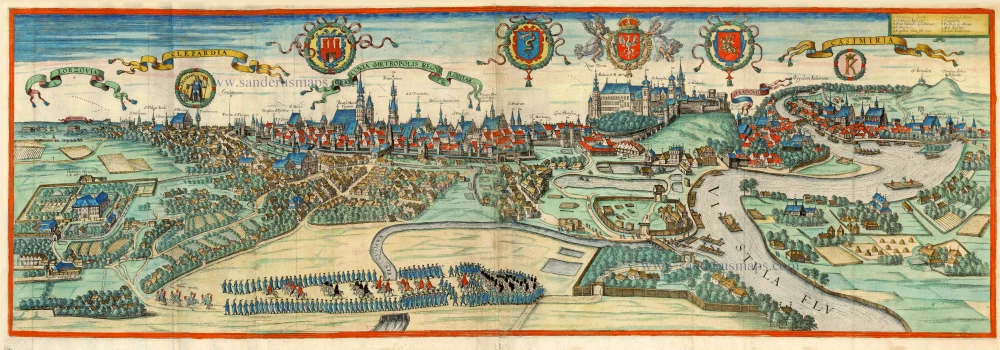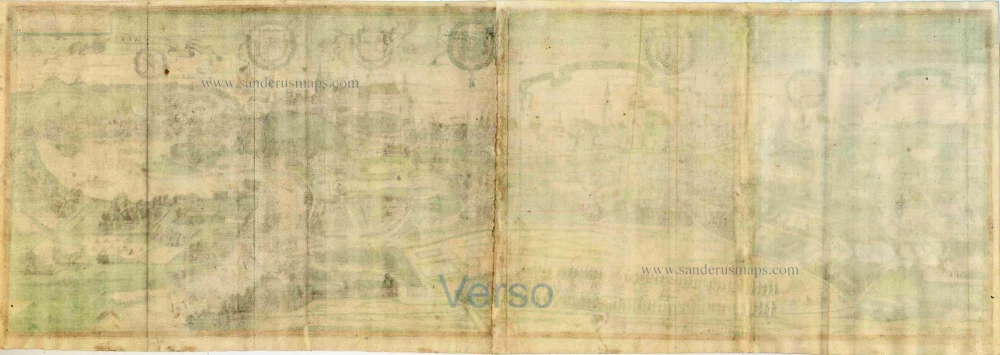Cracow and surroundings, by Georg Braun and Frans Hogenberg. 1617-18
TRANSLATION OF TITLE: Cracow, capital of the Kingdom of Poland. COMMENTARY BY BRAUN: "The splendid and vast city of Cracow is not only the residence of the king, but also the place where the royal treasury is. [...] Many people divide the city into three independent parts, each with its own town hall and court of justice. One is called Clepardia and lies on the side of Cracow leading to Silesia. But the city itself lies on a hill, called Wawel Hill, and at the top of it there is a royal palace. [...] As far as the city of Cracow is concerned, it has many fine churches and monasteries. Almost in the middle of the city is the main church dedicated to St Mary, roofed with shining lead and with two very high towers. An archbishop presides over this church." This magnificent folded plate is the only one of its kind in the city atlas and may be seen as a testimony to Cracow's importance at the time as a royal residence, episcopal see and university town. This is a view of the city from the west looking over the place where the Rudawa flows into the Vistula. The central feature is the royal palace, framed by the Old Town on the left and the suburb of Stradom on the right. The Old Town is surrounded by a moat and a wall with many towers, while the Jewish suburb of Kazimierz can be seen on the far right, on the other side of the Vistula. It is possible that the scene in the foreground represents the entry of the Polish king accompanied by knights and ecclesiastical dignitaries. The banderole celebrating Cracow as the royal residence would seem to confirm this. The plate was out of date at the time the book was published, and Georg Braun was ill informed, for Cracow had been replaced as the capital by Warsaw under Sigismund III between 1596 and 1611. (Taschen)
Braun G. & Hogenberg F. and the Civitates Orbis Terrarum.
The Civitates Orbis Terrarum, or the "Braun & Hogenberg", is a six-volume town atlas and the most excellent book of town views and plans ever published: 363 engravings, sometimes beautifully coloured. It was one of the best-selling works in the last quarter of the 16th century. Georg Braun wrote the text accompanying the plans and views on the verso. Many plates were engraved after the original drawings of a professional artist, a professional artist, Joris Hoefnagel (1542-1600). The first volume was published in Latin in 1572, and the sixth in 1617. Frans Hogenberg created the tables for volumes I through IV, and Simon van den Neuwel made those for volumes V and VI. Other contributors were cartographers Daniel Freese and Heinrich Rantzau. Works by Jacob van Deventer, Sebastian Münster, and Johannes Stumpf were also used. Translations appeared in German and French.
Following the original publication of Volume 1 of the Civitates in 1572, seven further editions of 1575, 1577, 1582, 1588, 1593, 1599 and 1612 can be identified. Vol.2, first issued in 1575, was followed by further editions in 1597 and 1612. The subsequent volumes appeared in 1581, 1588, 1593, 1599 and 1606. The German translation of the first volume appeared from 1574 on, and the French edition from 1575 on.
Several printers were involved: Theodor Graminaeus, Heinrich von Aich, Gottfried von Kempen, Johannis Sinniger, Bertram Buchholtz and Peter von Brachel, who all worked in Cologne.
Georg Braun (1541-1622)
Georg Braun was born in Cologne in 1541. After his studies in Cologne, he entered the Jesuit Order as a novice. 1561, he obtained his bachelor's degree, and in 1562, he received his Magister Artium. Although he left the Jesuit Order, he studied theology, gaining a licentiate in theology.
Frans Hogenberg (1535-1590)
Frans Hogenberg was a Flemish and German painter, engraver, and mapmaker. He was born in Mechelen as the son of Nicolaas Hogenberg.
By the end of the 1560s, Frans Hogenberg was employed upon Abraham Ortelius's Theatrum Orbis Terrarum, published in 1570; he is named an engraver of numerous maps. In 1568, he was banned from Antwerp by the Duke of Alva and travelled to London, where he stayed a few years before emigrating to Cologne. He immediately embarked on his two most important works, the Civitates, published in 1572 and the Geschichtsblätter, which appeared in several series from 1569 until about 1587.
Thanks to large-scale projects like the Geschichtsblätter and the Civitates, Hogenberg's social circumstances improved with each passing year. He died as a wealthy man in Cologne in 1590.
Cracovia Metropolis Regni Poloniae - Lobzovia - Clepardia - Casimiria.
Item Number: 27589 Authenticity Guarantee
Category: Antique maps > Europe > Eastern Europe
Old, antique bird's-eye view of Cracow and surroundings, by Georg Braun and Frans Hogenberg.
With key to ten locations.
Date of the first edition: 1617
Date of this map: 1617-18
Copper engraving, printed on paper from two plates, joined.
Size (not including margins): 37 x 110cm (14.4 x 42.9 inches)
Verso text: German
Condition: Original coloured, new side margins, minor repairs in centre, nice copy.
Condition Rating: A
References: Van der Krogt 4, #2151, State 1; Fauser, #6964; Taschen, Br. Hog., p.481; Niewodniczanski, K105/6.
From: Civitates Orbis Terrarum. Theatri praecipuarum Totius Mundi Urbium Liber Sextus Anno MDCXVIII. Cologne, Anton Heirat, 1617-18. (Van der Krogt 4, 41:1.6)
TRANSLATION OF TITLE: Cracow, capital of the Kingdom of Poland. COMMENTARY BY BRAUN: "The splendid and vast city of Cracow is not only the residence of the king, but also the place where the royal treasury is. [...] Many people divide the city into three independent parts, each with its own town hall and court of justice. One is called Clepardia and lies on the side of Cracow leading to Silesia. But the city itself lies on a hill, called Wawel Hill, and at the top of it there is a royal palace. [...] As far as the city of Cracow is concerned, it has many fine churches and monasteries. Almost in the middle of the city is the main church dedicated to St Mary, roofed with shining lead and with two very high towers. An archbishop presides over this church." This magnificent folded plate is the only one of its kind in the city atlas and may be seen as a testimony to Cracow's importance at the time as a royal residence, episcopal see and university town. This is a view of the city from the west looking over the place where the Rudawa flows into the Vistula. The central feature is the royal palace, framed by the Old Town on the left and the suburb of Stradom on the right. The Old Town is surrounded by a moat and a wall with many towers, while the Jewish suburb of Kazimierz can be seen on the far right, on the other side of the Vistula. It is possible that the scene in the foreground represents the entry of the Polish king accompanied by knights and ecclesiastical dignitaries. The banderole celebrating Cracow as the royal residence would seem to confirm this. The plate was out of date at the time the book was published, and Georg Braun was ill informed, for Cracow had been replaced as the capital by Warsaw under Sigismund III between 1596 and 1611. (Taschen)
Braun G. & Hogenberg F. and the Civitates Orbis Terrarum.
The Civitates Orbis Terrarum, or the "Braun & Hogenberg", is a six-volume town atlas and the most excellent book of town views and plans ever published: 363 engravings, sometimes beautifully coloured. It was one of the best-selling works in the last quarter of the 16th century. Georg Braun wrote the text accompanying the plans and views on the verso. Many plates were engraved after the original drawings of a professional artist, a professional artist, Joris Hoefnagel (1542-1600). The first volume was published in Latin in 1572, and the sixth in 1617. Frans Hogenberg created the tables for volumes I through IV, and Simon van den Neuwel made those for volumes V and VI. Other contributors were cartographers Daniel Freese and Heinrich Rantzau. Works by Jacob van Deventer, Sebastian Münster, and Johannes Stumpf were also used. Translations appeared in German and French.
Following the original publication of Volume 1 of the Civitates in 1572, seven further editions of 1575, 1577, 1582, 1588, 1593, 1599 and 1612 can be identified. Vol.2, first issued in 1575, was followed by further editions in 1597 and 1612. The subsequent volumes appeared in 1581, 1588, 1593, 1599 and 1606. The German translation of the first volume appeared from 1574 on, and the French edition from 1575 on.
Several printers were involved: Theodor Graminaeus, Heinrich von Aich, Gottfried von Kempen, Johannis Sinniger, Bertram Buchholtz and Peter von Brachel, who all worked in Cologne.
Georg Braun (1541-1622)
Georg Braun was born in Cologne in 1541. After his studies in Cologne, he entered the Jesuit Order as a novice. 1561, he obtained his bachelor's degree, and in 1562, he received his Magister Artium. Although he left the Jesuit Order, he studied theology, gaining a licentiate in theology.
Frans Hogenberg (1535-1590)
Frans Hogenberg was a Flemish and German painter, engraver, and mapmaker. He was born in Mechelen as the son of Nicolaas Hogenberg.
By the end of the 1560s, Frans Hogenberg was employed upon Abraham Ortelius's Theatrum Orbis Terrarum, published in 1570; he is named an engraver of numerous maps. In 1568, he was banned from Antwerp by the Duke of Alva and travelled to London, where he stayed a few years before emigrating to Cologne. He immediately embarked on his two most important works, the Civitates, published in 1572 and the Geschichtsblätter, which appeared in several series from 1569 until about 1587.
Thanks to large-scale projects like the Geschichtsblätter and the Civitates, Hogenberg's social circumstances improved with each passing year. He died as a wealthy man in Cologne in 1590.




